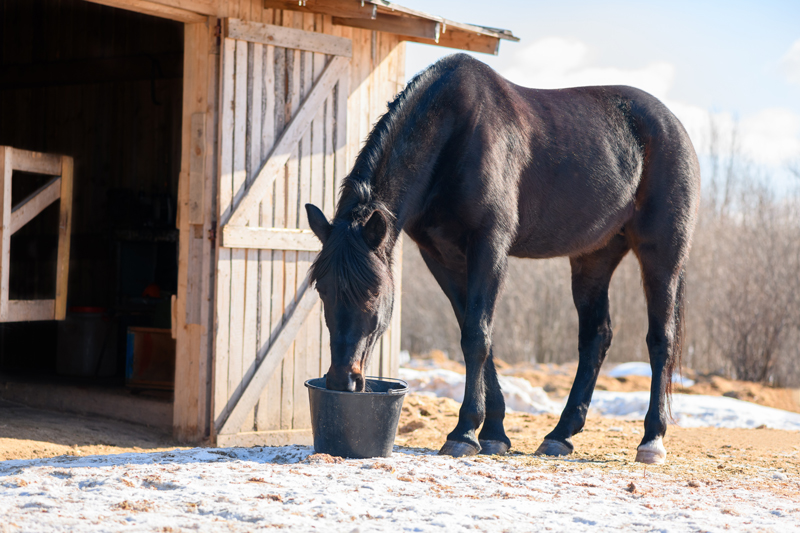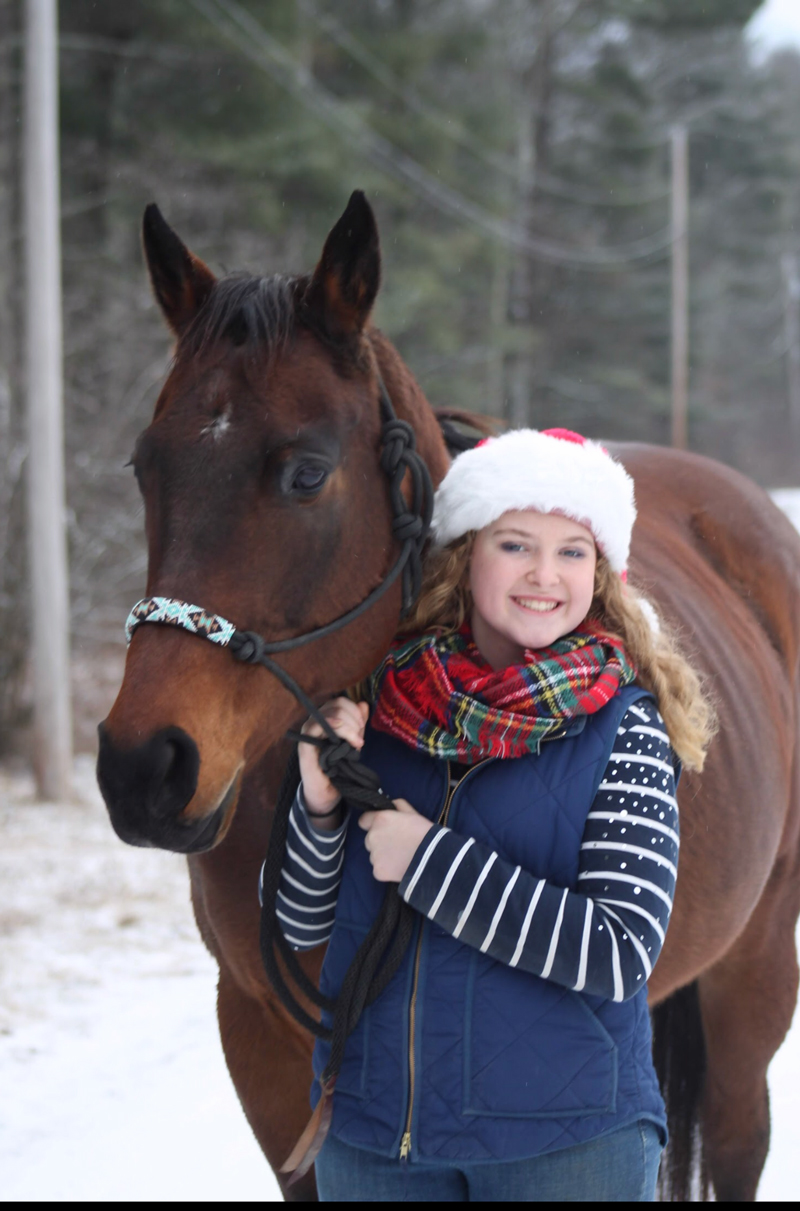Tips on Winter Horse Care from Vermont’s Equine Experts
STORY BY BENJAMIN LERNER
Winter in Vermont is a spectacularly beautiful season. As shimmering blankets of fresh powdered snow start to cascade down upon the majestic Green Mountain peaks, equine enthusiasts statewide stand ready to begin their winter preparations. Keeping horses happy and healthy during the winter requires love, care, and dedication. For horse owners who are relatively inexperienced, creating a proper winter horse care program might seem like a daunting task. Fear not! Vermont’s seasoned horse-caretakers and well-qualified veterinarians are happy to shed light on a number of precious horse care secrets. By taking the time to create a proper winter horse care plan, horse lovers everywhere can ensure the comfort and well-being of their beloved hoofed companions – and safeguard the future of their health for years to come.

Andrea Conrad’s Tips for Winter Diet, Blanketing, and Exercise
Southwest Vermont-based equine expert Andrea Conrad has been taking care of horses since her early childhood. Andrea is a native Vermonter who fondly remembers growing up in Londonderry, where her mother made a living taking care of horses. “My mother ran a show barn. She was the trainer there. I was literally raised in a bassinet in the barn. I was born into the horse-care culture. It’s always been a huge part of my life.”
Andrea recalls: “Growing up, my life was every horse-loving little girl’s dream. I was surrounded by horses and ponies. I was pretty sure that each and every one of them belonged to me – even though most of the time they definitely didn’t. I’ve been showing horses since I was three years old. I started out showing horses in ‘leadline’ horse shows for young kids. As I grew older and my skills developed, I continued to refine my abilities as a show horse trainer. Before long, I was training horses professionally. I would work with my clients’ horses to build their confidence so that they would be ready to progress to the higher echelons of competition.”
Andrea currently owns two show horses of her own named Gem and Belle, as well as a Welsh pony named Clover. As a long-established equine professional, she is passionate about ensuring that every horse in her stable receives proper care – regardless of the season. Andrea says that one of the most important elements to proper horse care is nutrition. “Proper access to quality food and temperature-controlled water is vitally important. Those factors become even more important in the winter.”
Andrea explains that “if a horse is kept in an area where there is fresh grass for them to graze on during the summer, the grass provides a much higher moisture content than the dried hay and grain that most horses eat in the winter. To compensate for this loss in moisture content during the colder months, it’s best to give your horses additional water. If they don’t drink enough water, they may eat less and become more prone to sickness or digestive problems. Water temperature is important too. It’s essential to keep the water above freezing – ideally in-between 45° and 60° Fahrenheit. You should always make sure to clean your horses’ water source as well. Salt intake is also crucial. It’s best to provide your horses with salt on a daily basis. During the winter, salt licks tend to freeze more easily. Some people find loose salt to be the best solution for this problem.”
According to Andrea, horses also need to eat more during the winter due to the fact that “they need more energy during the winter months to produce more body warmth. This is especially important for young horses, who can lose body heat much faster than adult horses. Another thing to keep in mind is that the more the temperature drops, the more food the horses will require to maintain a healthy body temperature. Other factors come into play, as well – such as the length of a horse’s coat. Some people choose to let their horses’ hair grow out during the winter season, but longer coats can require a lot of grooming and maintenance. That maintenance can cut back on the amount of time that you have available to focus on other important aspects of horse care. If you don’t want to grow your horses’ hair out for the winter, it’s best to blanket the horses so that they can continue to exercise outside during the winter months. It’s also important to make sure that the blanket is fitted correctly. If it isn’t, the horses can develop cuts and abrasions near the straps.”
Andrea stresses that “exercise during the winter months is also incredibly valuable to horses. Many owners will tend to confine their horses more in the winter, but that can lead to health concerns that are easily avoidable, such as swelling of the lower legs. Vermont is such a great place to exercise horses – and the winter months are no exception. One of my favorite things to do with my family is to take our horses out in the snow and let them enjoy it. It’s such a beautiful experience. Just make sure to properly blanket your horses, cool them down after exercise to make sure they’re not wet or sweaty when they return to the stables, and feed them more hay or grain to make up for any calories that they burn through exercise. You want to be certain to make decisions that will keep them healthy and thriving for years to come.”

Dr. Bob Wendell’s Tips for Shelter and Healthcare Maintenance
Dr. Bob Wendell of Aeolus Animal Hospital and Equine Center in Dorset has an extensive background in horse training and veterinary science. Dr. Bob says he got his start in the field of horse care by training horses when he was a young man. “I paid for part of my college education by training horses how to jump. I was born right outside of Boston. I went to an old-school vocational agriculture high school in Massachusetts. They had a great animal science program there. I’ve always loved horses. It’s been a lifelong passion of mine.”
According to Dr. Bob, one of the most important factors in winter horse care is “proper shelter that takes environmental factors into account – such as wind direction and sun trajectory. Some people build their horse shelter structures with only aesthetics in mind. Though the structures may look nice in their yard relative to their house, sometimes the placement isn’t very practical. Different types of structures require different considerations to ensure the health of horses during the wintertime. If you have a “run-in-shed” with open entrances, it’s best to orient the shed openings towards a southern exposure so that the horses are both sheltered from the wind and warm all day. A regular barn stable has to be well-ventilated. Ceiling fans can make a valuable difference in regards to air circulation. You also have to make sure to remove wet bedding and manure from the barn or stable whenever possible. In general, horses handle winter cold fairly well, but they can’t be left out in the wind when they’re wet. Sometimes this can happen when it’s snowing. Snow will fall on the horses, and then start to melt due to their body heat. After the snow melts, the water clings to their coat. When the temperature drops, the water will then freeze. It takes a lot of calories for the horses to handle that kind of elemental exposure. Due to this phenomenon, it’s best to create structures that will allow the horses to escape the elemental forces and find shelter during the coldest and snowiest periods of the season. If you use a paddock-style enclosure for your horses, you need to make sure that you are regularly sanding or salting the paddock to counteract the loss in traction that can come from wintry ice. If you don’t, horses can trip and fall – and possibly injure themselves. Sand can increase the traction on the ice, and salt can help the ice melt faster, but It’s incredibly important not to combine the two, because the horses might accidentally ingest some sand.”
Dr. Bob also warns that one of the important areas of equine healthcare happens to also be one of the most overlooked. He cautions that “it’s essential to stay on top of foot management. Horse hooves tend to generally grow slower in the winter, but horse owners should still be scheduling regular trimmings. Horses are also in greater danger of falling during the wintertime. That’s why it’s important to call in a farrier to trim and balance their feet. In the winter months, the horses will be on non-dry footing. You have to take all the steps necessary to ensure their feet are properly maintained, and also take them in for regular veterinary checkups.”
Dr. Bob’s most urgent piece of advice to horse owners is to “use common sense when making decisions concerning the health and well-being of your horses. If you’re going to do research on the subject, make sure that everything that you read is peer-reviewed. Talk with your veterinarians. We’re here to help. You should always be able to ask your vet anything. Never be afraid to ask questions or learn more. The most fulfilling part of my job is being able to make a critical positive difference in the healthcare and treatment of the horses that are such an important part of my clients’ lives. Those types of positive outcomes all depend on horse owners working closely and communicating openly with their veterinary service providers to determine the best course of action for their horses on a daily basis.”
Publisher’s Note:
Old Mill Road Media, LLC is not an authority on horse care. OMRM, LLC encourages horse owners to consult with licensed veterinary professionals when making horse care and horse-health decisions.

